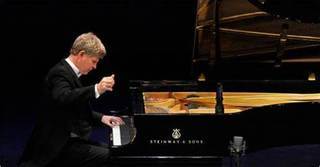|
Back
The Dreams of Angels New York
Tenri Cultural Center
04/21/2023 -
Robert Schumann: Drei Romanzen, Opus 28 – Nachtstücke, Opus 23 – Humoreske, Opus 20
Ian Hobson (Pianist) 
I. Hobson
“All week I’ve been sitting at the piano and composing and writing and laughing and crying, all at the same time. You will find this in the great Humoreske.””
Robert Schumann
“Schumann’s intimate approach salutes us, not so much an audience to be conquered as a friend to be talked over with gentle persuasion.”
Sir Thomas Beecham
Adjustment is the key to appreciating Ian Hobson in his continuing Schumann Cycle at Tenri Cultural Center. No matter how one prepares, the walls of this small concert hall reverberate, and one must adjust ears and mental faculties to hear the souls beneath the skin.
Chopin’s notes can be augmented into naked emotions with these reverberations. Mozart’s lines could never be faulted no matter what the surroundings. But Robert Schumann? The first work on this program of non‑vintage music started with an etude bouncing off the walls, the melody peeking through the echoes. Ditto for the finale of the Three Romances, whose challenges were artfully essayed by Mr. Hobson. Ideas after ideas were jammed together.
But ah! When Mr. Hobson played the middle Romance, one began to appreciate his mastery. The melody could be charming. But Ian Hobson played it with the depth of a Schumann song. One could be, for the first time, transported from the familiarity of audience and piano into the composer’s singular Elysium.
Perhaps another quandary was Schumann’s genius, a genius unfettered. “Romance” is amorphous enough a title, that Schumann’s Romanticism ran wild.
That, though, though was hardly true for the Night Pieces. Clara wanted to call them “Night Visions”, and Robert wanted to stick a “corpse” word to the title, for they referred to deaths of various relatives and friends.
Just because of that, the works were more confined, more simply moods instead of dazzling piano virtuosity. The moods might have been morbid, but Mr. Hobson never allowed his piano to sink into pathos. In fact, he was able, even within the Tenri Hall to give a spatial vision of the opening. Like Mendelssohn’s Italian Symphony slow movement, he gave us a funeral procession gradually approaching, resounding to a fortissimo intensity and then...well, then receding into the distance.
It was an aural illusion, but it worked. Working so well, that one was jolted by the scherzo‑like character of the second piece and the breathlessness of the penultimate movement. Mr. Hobson preserved his strangest most exalted moments for the finale.
It’s difficult to see how even the most eccentric Schumann pianists (I am thinking, of course, of Radu Lupu) can handle the lyricism, the changes of mood with cohesion. Mr. Hobson came close. But not a word of carping could be uttered at those last soft, almost silent notes. The pianist came close to showing that Schumann had resisted all the fireworks, for Night Music demanded darkness, if not gloom.
The second half was a creation of unalloyed joy. Humoreske was hardly our sense of humor. Robert Schumann was exceptionally aware of history and literature. And he knew that in ancient days “humors” were the four fluids which determined our four emotions. Thus, in the 15 connected movements, Schumann stayed close to his subject.
Yes, he sometimes went wild with difficulties. But the composer remained close to his subject. And in one 30‑minute work, he came close to the cohesive pictures of Carnaval, even his C Major Fantasia. This was also Ian Hobson at his greatest. Not monumental pianism, not pictures of corteges or romance. Rather, Mr. Hobson was able to tie each short section together, as if foreordained.
From the dreamlike start–and dream is the operative word here–he brought us through traumatic images of urgency and longing, through instability and Keats’ notes unspoken. With an ending equivalent to his childhood scene, “The Poet Speaks.”
Humoreske was perhaps a premonition of Schumann’s own descent into madness and hallucination. Yet transforming madness into the most beatific music was a miracle which only Schumann could have produced. Ian Hobson has both the poetry and deft technique to make that dream an aural reality.
The encore was Schumann at his at his least embellished. The Myrthen songs were presented to his wife on their wedding. And “Widmung” (“Dedication”) led Franz Liszt to give the most unadorned arrangement. Ian Hobson gave it the loveliest rendition of all. He made it sing. Schumann’s singing makes those clamorous harp-twanging angels oh so silent.
Harry Rolnick
|